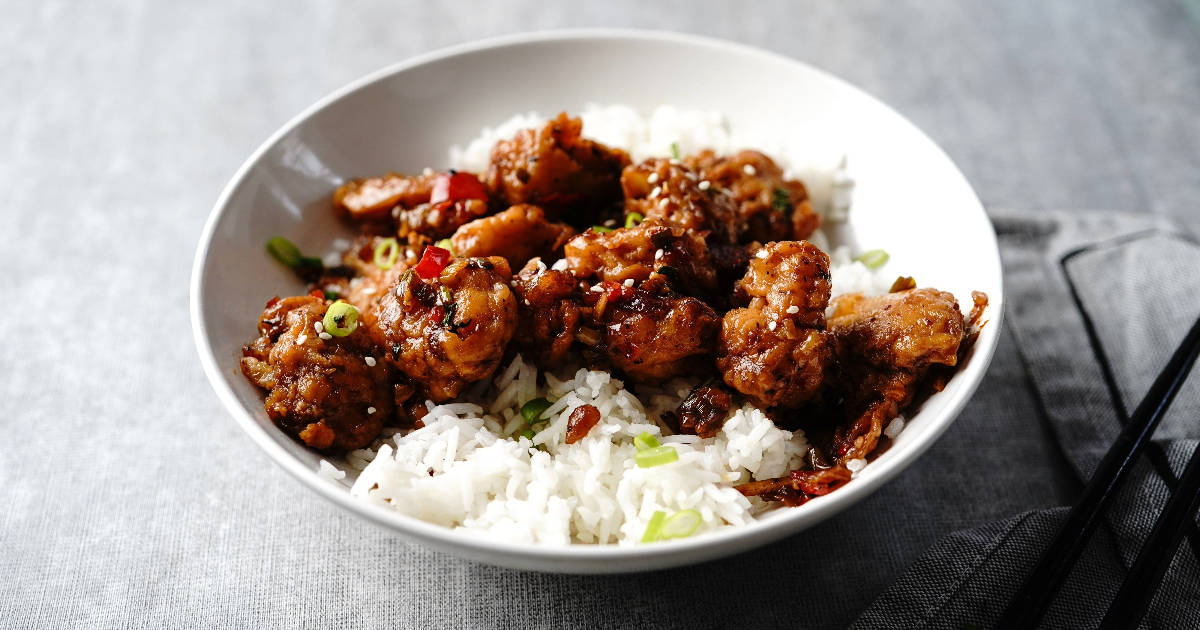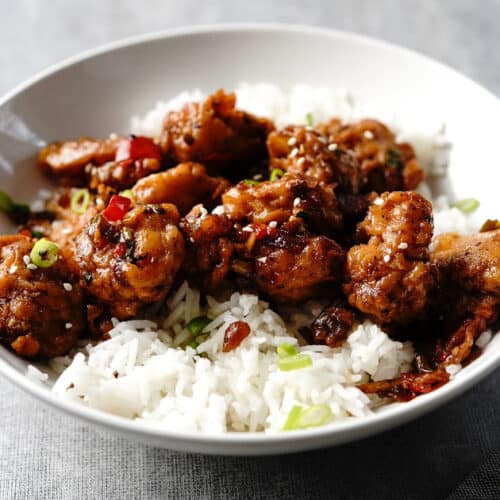Gochujang, a savory and spicy fermented Korean chili paste, adds a delicious kick of flavor to roasted cauliflower.

When paired together, the mild sweetness of caramelized cauliflower florets complements the tangy umami of gochujang.
This Korean-inspired gochujang cauliflower recipe is easy to make at home and can be enjoyed as a healthy appetizer, side dish, or main course.
Preparing the Cauliflower
Start with fresh cauliflower florets. Remove any leaves and cut the head into small, bite-sized pieces. The size of the florets is up to you, but uniform, similar-sized pieces will cook more evenly.
Toss the cauliflower florets with a small amount of oil - olive, avocado, or vegetable oil all work well. Spread them out on a baking sheet in a single layer, avoiding overlap. Season lightly with salt and pepper.
Roast at 400°F for 15-20 minutes, until lightly browned and tender when pierced with a fork. Flip halfway through for even cooking. The cauliflower should be just shy of done before adding the gochujang sauce.
Making the Gochujang Sauce
While the cauliflower roasts, prepare the gochujang sauce. This can be done ahead of time as well.
In a small bowl, whisk together:
- Gochujang - Start with 2-4 tablespoons, depending on the desired spice level. Add more for extra heat.
- Soy sauce or tamari - 1-2 tablespoons add salty umami. Use tamari for a gluten-free option.
- Maple syrup - 1-2 tablespoons balances out the spice with sweetness.
- Rice vinegar - 1-2 teaspoons brightens up the sauce.
- Toasted sesame oil - 1 teaspoon enhances nuttiness.
- Garlic - 1-2 cloves, minced, pumps up the aroma.
- Ginger - 1 teaspoon freshly grated adds a little kick.
- Cornstarch - 1 teaspoon helps thicken the sauce.
Whisk all ingredients together until smooth. The cornstarch will help the sauce cling to the cauliflower.
Coating the Cauliflower
Once the cauliflower is just shy of being done roasting, remove it from the oven.
Pour the prepared gochujang sauce over the cauliflower and toss gently to coat. You can do this on the baking sheet or transfer the cauliflower to a bowl first.
Return the sauced cauliflower to the baking sheet and place back in the oven. Roast for 10-15 minutes more until the sauce is sticky and caramelized.
Serving Suggestions
These gochujang cauliflower florets make fantastic finger food for parties and game-day snacking. Or turn them into a complete meal by serving over rice with sliced scallions. They can also be tucked into lettuce wraps or sandwiches.
Some tasty additions:
- Toasted sesame seeds
- Sliced scallions
- Chopped cilantro
- Lime wedges
- Vegan mayo or ranch
Gochujang cauliflower keeps well refrigerated for 3-4 days. Reheat in the oven to crisp it back up.
Make-Ahead Tips
With a few tweaks, this flavorful recipe can be made ahead of time:
- Roast the cauliflower florets up to 3 days in advance. Store tossed in a little oil in an airtight container.
- Prepare the gochujang sauce up to 5 days ahead. Store covered in the refrigerator.
- When ready to serve, toss the roasted cauliflower with the sauce and bake as directed.
Variations
There are so many ways to customize gochujang cauliflower:
Gochujang Cauliflower Wings
Transform the roasted florets into spicy, sticky wings:
- Toss cauliflower pieces in a light coating of cornstarch, then roast.
- Once done, coat with the prepared gochujang sauce.
- Broil 2-3 minutes to get crispy edges.
Gochujang Tofu
Swap in cubed, pressed tofu instead of cauliflower for a protein-packed option:
- Press and cube extra firm tofu.
- Toss with cornstarch and bake until golden.
- Coat baked tofu in gochujang sauce and broil.
Gochujang Tempeh
Marinated, baked tempeh also stands up well to the gochujang sauce:
- Cut tempeh into strips and marinate in soy sauce, maple, and oil.
- Bake tempeh until browned, then coat with sauce and broil.
Gochujang Veggie Bowl
Build a bowl using the gochujang cauliflower and your choice of grains and vegetables:
- Quinoa or brown rice
- Sauteed greens like spinach or kale
- Steamed broccoli
- Kimchi
- Sliced avocado
- Roasted sweet potato
- Pickled vegetables
Adjusting Heat Level
The amount of gochujang in the sauce directly impacts the heat level. For mild spice:
- Start with just 1 tablespoon of gochujang
- Add more vinegar, maple, or tahini to balance out the chili.
To really turn up the heat:
- Use 1/4 cup or more gochujang
- Add an extra pinch of red pepper flakes
- Use less maple syrup to keep it extra spicy
Taste the sauce before coating the cauliflower and adjust until you reach the desired spiciness. Play around with the ingredient ratios until you find your favorite gochujang cauliflower recipe.
FAQs
What if I can't find gochujang paste?
Substitute with another chili garlic sauce like sambal oelek or Sriracha. The flavor won't be exactly the same but you'll still get heat.
Can I use regular vinegar instead of rice vinegar?
Rice vinegar is preferred for its mild sweetness, but white wine vinegar or cider vinegar also works. Start with a bit less, as they are more strongly acidic.
How spicy does this dish end up?
It depends on the amount of gochujang used, but most recipes result in a medium spice level. Adjust to taste by modifying the gochujang amount and other sauce ingredients.
Should I add cornstarch to the sauce?
The cornstarch helps the sauce nicely coat the cauliflower but isn't mandatory. Without it, the sauce will be thinner.
Can I use orange cauliflower or broccoli instead?
Absolutely! The sweet flavor of orange cauliflower is delicious with gochujang. Broccoli florets also work well.
Is gochujang cauliflower gluten-free?
Yes, as long as you use tamari instead of soy sauce and a gluten-free gochujang brand. Be sure to check the labels.
Conclusion
Gochujang, the punchy Korean fermented chili paste, truly transforms mild roasted cauliflower into an irresistible snack or meal.
The savory umami flavor of gochujang, balanced by sweet and tangy ingredients like maple and rice vinegar, makes for addictive cauliflower.
This easy recipe can be tweaked and customized to suit any palate. Try gochujang cauliflower wings, gochujang tofu, or build your own gochujang veggie bowl for a healthy dinner.
The flavor possibilities are endless with this Korean-inspired cauliflower recipe!

Gochujang Cauliflower
Ingredients
- 1 head cauliflower, cut into florets
- 2 Tbsp olive oil
- 2-4 Tbsp gochujang
- 1-2 Tbsp soy sauce or tamari
- 1-2 Tbsp maple syrup
- 1-2 tsp rice vinegar
- 1 tsp toasted sesame oil
- 1-2 cloves garlic, minced
- 1 tsp fresh grated ginger
- 1 tsp cornstarch
- Salt and pepper to taste
Instructions
- Toss cauliflower florets with olive oil. Spread in single layer on baking sheet.
- Roast at 400°F for 15-20 minutes until browned and tender.
- In a small bowl, whisk together gochujang, soy sauce, maple syrup, rice vinegar, sesame oil, garlic, ginger, and cornstarch.
- Pour sauce over roasted cauliflower and toss to coat.
- Roast 10-15 minutes more until sauce thickens.
- Season with salt and pepper to taste.
- Serve over rice garnished with sesame seeds and scallions.

